MARSOSE CORPS, THE DUTCH SPECIAL ARMY
The Marechaussee te Voet Corps, known in Indonesia as the Marsose corps, was a military unit established during the colonial period of the Dutch East Indies by the KNIL (colonial army) as a tactical response to the guerrilla resistance in Aceh. This corps has no ties to Koninklijke Marechaussee in the Netherlands.

On August 6, 1897, a unit of the Marechaussee Corps, attacked the landscape of Soekoen (near Sigli) and killed more than 57 men. Only a few minutes later after their action pose while stepping on the bodies of the Aceh martyrs for photographer Christiaan Benjamin Nieuwenhuis. News of the victory was immediately sent to Batavia and the Netherlands.
Marsose was assigned in the Indies, among others in the battle against Sisingamangaraja XII in North Sumatra, which in 1907 defeated and killed Sisingamangaraja XII. In the Aceh War, Marsose controlled the mountains and jungle forests in Aceh to seek and pursue Acehnese guerrillas.
Background The Aceh War is very detrimental to the Netherlands.
In 1873 began a terrible war between the people of Aceh against the Dutch occupation. As Ibrahim recounts in his book “Perang di Jalan Allah, Perang Aceh 1873-1912”, the Acehnese war resulted in so many fatalities on both sides. Not just troops vs. troops, but also the massacre of civilians of Aceh by the Dutch Colonial army.
On the side of the Dutch colonizers themselves, the number of victims swelled by many troops who fought, did not have the ability to fight. Or it could be said that the death rate was also in vain in the Aceh War. One of the reasons why so many casualties and so terrible war, was because, in this war, guerrilla techniques were used so perfectly by the forces of Aceh when facing Dutch troops.
Ianah Wulandari, Historian of Universitas Negeri Surabaya in his article entitled “Mareschausse Corps Unit in Aceh in 1890-1930”, confirmed a series of guerrilla attacks. To the extent that, in the Aceh war, the Dutch did not give much resistance. The Dutch troops were surrounded by hard-to-find guerrillas of Acehnese warriors. Not to mention the hilly geographical conditions in Aceh, many rivers, and many mountains and forests make Acehnese insurgents increasingly difficult to trace Dutch troops. As a result, the Dutch could only defend its territory, which was captured at the beginning of the war.
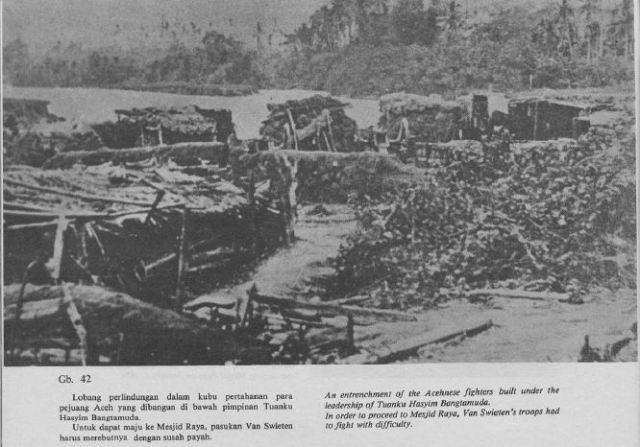
Defense hole in the stronghold of the Acehnese warriors built under the leadership of Tuanku Hasyim Bangtamuda – To go forward to attack the Great Mosque Van Swieten forces seized the fortress with great difficulty.
At first, the Dutch thought it would be easy to conquer the Aceh Sultanate. In fact, from 1873 to early 1880, the Netherlands gained so much loss, worth up to 115 million florins. The cost is so great compared to the results obtained. Dutch within that period were only able to control Aceh in the area of 74 Km2. That is, the Dutch are only able to control the territory of the capital city of Aceh; Koetaradja (Palace), and around the Great Mosque of Aceh. Beyond that, the Netherlands has no power whatsoever. The Dutch were surrounded by Acehnese rebel forces, and this also benefited the Aceh troops. Their enemy, the Dutch troops like being herded at a single point of the battle. Making it easier for the Acehnese guerrillas to conduct tactical attacks that produce a large effect. At the beginning of the Dutch battle using the strategy “Gecocentreerde Linie” or a very conventional defense pattern. From a series of failures experienced by the Dutch, they decided to use different tactics than they ever had.
The Dutch eventually hired an anthropologist to study the Acehnese. A person named Snouck Hurgronje was an anthropologist to “spy” and charted the hard-to-be-defeated Acehnese people in battle. One of Hurgronje’s tasks is to investigate the socio-cultural conditions of the Acehnese society so that the Dutch can enter and control the people of Aceh. Snouck Hurgronje’s research results related to Aceh and Islam War in Indonesia which have been booked are:
- The Achehnese;
- Advices C. Snouck Hurgronje during his services to Dutch Indies Government 1889-1936. 11 Volumes.
The proposed strategy of Snouck Hurgronje to Dutch Military Governor Joannes Benedictus van Heutsz was that the Keumala group (the Sultan’s party based in Keumala) with his followers was put aside. Keep attacking and holding on to the ulamas (clerics) constantly. Do not negotiate with guerrilla leaders. Establish a permanent base in Aceh Besar. Demonstrate (intent) good Dutch to the people of Aceh, by establishing langgar (small mosque), mosque, repairing irrigation roads, and helping the social work of the people of Aceh. It turned out that Dr. Snouck Hurgronje’s ploy was accepted by Van Heutz who became the military and civilian governor of Aceh (1898-1904). Then Dr. Snouck Hurgronje was appointed as his advisor.
Background Forming the Marsose Troops
Furthermore, in a series of ways to rule Aceh, at the suggestion of a Minangkabau named Mohammad Syarif or Mohammad Arif a chief prosecutor in Koetaradja (Banda Aceh now). The man born in Minang sparked the formation of a special forces corps formed to confront the Acehnese guerrillas. Syarif himself was an indigenous Indonesian, who supported the Dutch government. He gave the proposal to the Dutch Military Governor in Aceh, General van Teijn and also to the Chief of Military Staff J.B. van Heutsz to form a small, highly mobile infantry combat unit. These troops are certainly anti-guerrilla forces. In 1889, the Dutch Army Command in Aceh had compiled two detachments of mobile forces with anti-guerrilla capabilities.
The concept of the troop then matured again into an army of Marsose who eventually proved themselves as an elite troop because some heavy tasks that are difficult to do KNIL soldiers usually managed to finish them. How not, these troops are the choice of troops from various units of the KNIL both indigenous and European.
From the proposal, the concept of troops was then matured again until finally formed an elite force named troops Marsose or also known as Mareschausse Corps which was founded on April 2, 1890, and recorded in a letter signed by the Queen of the Netherlands entitled “Staatsblad Van Nederlandsch Indie “. This corps is not just any corps, this army is an army of choice from various units of KNIL both indigenous and Europe. They are none other than an army of cold-blooded mercenaries whose members are indigenous. Only the leader is a Dutchman.
Typical Characteristics of Marsose Soldiers
Marsose is a fast-moving force with a green uniform with red curved lines on the arms and neck with red lines. Each Marsose unit consists of 20 people led by a Dutch sergeant assisted by a native corporal. Each troop usually consists of a platoon consisting of 40 people and is led by a Dutch Lieutenant.

The dangerous ones, Marsose troops from Java posing after the operation into the forest in Aceh. The Marsose soldiers are Dutch Pride, they are qualified subordinates (H.C. Zentgraaff in his book The Atjeher).
Altogether, the Marsose corps consists of 1,200 people from various nations, composed of Dutch, French, Swiss, Belgian, African, Ambonese, Menado, Javanese, as well as some Nias and Timorese. These troops, in addition, armed with carbines, are also armed with traditional weapons such as klewang(machete), rencong (knife/bayonet), and so forth. They are not dependent on military transport and are on foot. They do not rely on logistical supply lines.
This is especially useful in melee warfare, man to man, as do indigenous guerrillas. Marsose tried to follow this fighting style because guerrilla guerrillas were so effective against the usual KNILs that prevailed on the big front but bothered when attacked abruptly. These troops are certainly trained in warfare in the jungle against insurgent attacks.
The excellence offered by these troops is because they are specially trained natives, they will be more familiar with their fellow enemies. That is, it can be said, this Marsose corps is assigned to kill their own compatriots. With sophisticated equipment in his day and a large salary, Marsose troops are known as cold-blooded elite.
Marsose, based on historical records, does more of his work as a counter-guerrilla force in Aceh and Batak land. These two areas were very difficult to control the colonial government until the early twentieth century. Marsose in large quantities is needed there for long time tasks. Even after the war against Batak people in the Sumatra and Aceh Hinterlands was over, little resistance sometimes still happened. As experienced by a former Marsose commander, Lieutenant Colonel W.B.J.A Scheepens, who stabbed rencong (knife) Acehnese people.
Marsose is not only assigned to these two areas but also in some places such as the Nusa Tenggara Archipelago as well as Sulawesi, although with few personnel. The story of the malignancy of Marsose troops is more prevalent in Aceh and Gayo land.
Special Forces Marsose was named Kolone Macan
The presence of Marsose as a special force that is so reliable, is apparently still considered not enough by senior Dutch military officials. The Dutch officers again formed a unit within Marsose’s army named Kolone Macan. Like Marsose, Kolone Macan was also led by officers from Europeans. One of them is a Swiss officer named Hans Christofell. He is well-known for contributing to the colonial government in the war in northern Sumatra. He set up a new special force again, in which the members were elected members of Marsose.
There is a Marsose officer who is higher in rank than Christoffel, Captain (later Lieutenant Colonel) Scheepens. After various considerations, the Dutch military policy-makers came to the conclusion that the sadistic work of the executioner was not suitable for Scheepens, although Scheepens was quite willing to do even heavy military tasks such as fighting for days in the forest. In the eyes of the policymaker, Christoffel is considered more suitable to lead a group of executioners. Christoffel finally departed to Cimahi, were standing a garrison of Dutch troops there. Here Christoffel met with many veteran Marsose and has experience fighting in Aceh. Their presence in Cimahi was in order to rest after the heavy war in Aceh for months.
He assembled a vicious member of Marsose, a bruiser. The troop was named Kolone Macan. These troops are trained by Christoffel in Garnisun Cimahi. Their clothing is gray-green in the collar of her shirt with two bloody fingering blisters. Of course, the red necktie looks scarier. They are known as the creepy troops with the nickname ‘cold-blooded killer’.
After resting for a long time, the Martians felt that they wanted to go back to war in Aceh again. The world of Marsose is definitely not a world of peaceful barracks, their world is war in the forest, as in Aceh. During the peaceful Cimahi barrack, the Marsose was also given the theory of war, but it was less responded to by low-educated marsose. They do not need theory in warfare but in battle. Naturally, the theory of war was not even digested Marsose warriors. They know better and love to fight. Another routine that they hate in the barracks is that several times a day have to line up. The marsose exercise is not firing a gun, but rather playing a klewang (machete).
In Cimahi, Christoffel picked up some brigade commanders who were usually the best sergeant Marsose. Those who are tired of living in the garrison are clearly a priority. These troops are made up of 12 marsose brigades who have been trained again in Cimahi. How well trained they are now. In the front row of Kolene Macan‘s troops is the unmarried Marsose. Obviously, they can fight more freely because they will not think about their children and their wives.
The way the troop’s work is crueler than Marsose before. They do execution on the spot. This is crazy, as one of Marsose Schriwanek’s commanders feels. Though he was a rough man, he saw the workings of Kolone Macan, perceived by the officer, to be completely outrageous when doing Sweeping. They cleaned the guerrilla movement of the people’s resistance cruelly from the lowlands. They do their work briefly and thoroughly.
The strong reaction to the work of Kolone Macan also emerged from the Dutch military itself. The battle they carried out in Aceh was outrageous. This reaction came from a Dutch officer who was not from a mercenary background. Finally, the command over the Aceh region was changed from van Daalen to Swart. Due to the change of command, the ruthless way of Kolone Macan was slowly removed. The troops once trained and led by Christoffel were then switched command to van der Vlerk. This new commander, like the demands of some Dutch officers who hated the cruelty of Van Daalen and Christoffel, began to change the nature of the Kolone Macan army. These troops disappeared for a long time and became just regular Marsose.
Kolone Macan is the cruelest part of the corps named Marsose and only plunges into the Aceh front only. The Colonial Government apparently did not want to be an army of organized executioners, for the colonial government, just marsose the cruelest troops they had. However, resistance to colonial policy is unpredictable when it occurs and this is the reason why Marsose continues to be preserved despite its diminishing role. Marsose did not sound great again when Japan landed in Indonesia.
Photos of the cruelty of Long March Marsose troops to Gayo under the leadership of General C.G.E van Daalen.
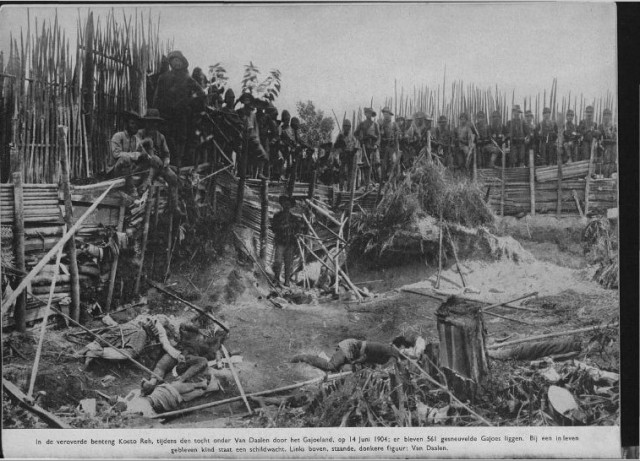
The conquest of Koeta Reh Fortress, an operation under the leadership of Van Daalen in Gayo Land. The photo was taken on June 14, 1904. Part of the Aceh War (1873-1904)
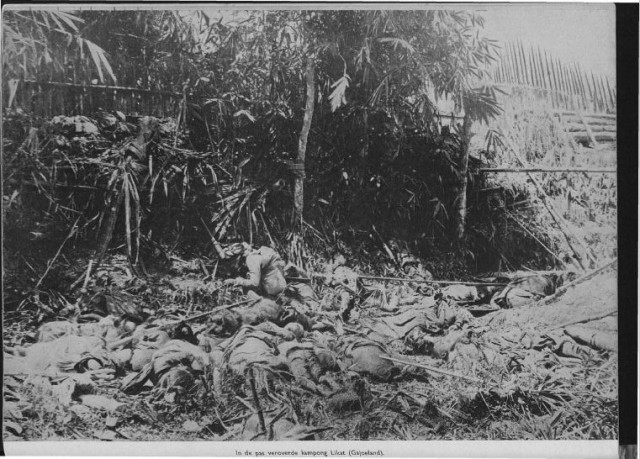
All the inhabitants of Koeta Reh fortress, women and children were massacred by the Van Daalen-led Dutch troops (Aceh War 1873-1904)

Dutch cruelty in Kampong Likat Tanah Gayo, children and women were also massacred by Van Daalen’s Dutch army. Aceh War (1873-1904).
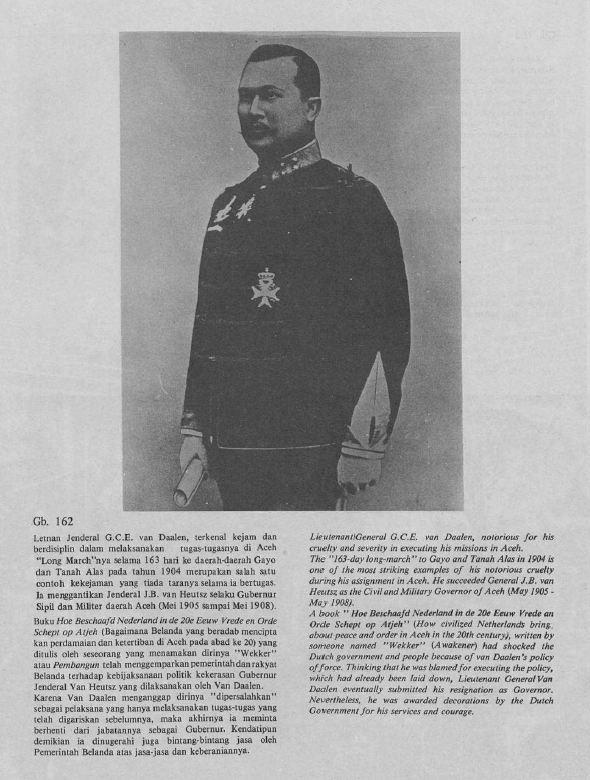
Lieutenant General G.C, E. van Daalen one of Marsose’s most violent leaders – During the Long March led for 163 days – He ordered the burning of the village – Killing women and children.
End of the Marsose Corps.
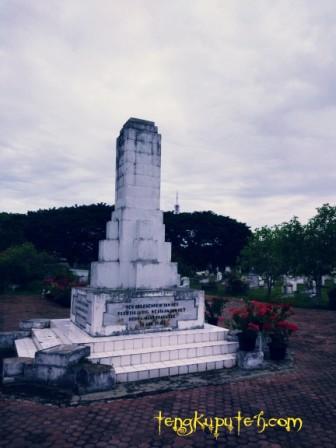
The honorary monument was built by the owners of plantations in East Sumatra to honor the 40th anniversary of the Marsose corps (1930) in Aceh. In 1930 also Marsose troops in Indonesia were dissolved by the Dutch East Indies colonial government
As a result of cruelty outside the limits of humanity, Marsose Corps was finally dissolved by the Dutch themselves. The story of Marsose’s history after the Aceh war was gone. In 1930 Marsose troops in Indonesia officially disbanded. As a result, the Dutch troops were sharp as they were during the Aceh War, easily conquered by the Japanese in the Second World War.
The heritage of Marsose.
The Dutch special forces tradition in Indonesia was revived by Lieutenant Colonel W.B.J.A Scheepens’s son, Captain W.J. Scheepens when the Dutch army landed in 1945. Captain Scheepens developed his idea of forming Special Forces (Speciale Troepens) so that the KNIL leadership approved it by establishing Depot Speciale Troepens (DST) on July 15, 1946.
DST troops characteristic of green-coated is commandeered by Captain W.J Scheepens personnel are also recruited from various tribes and nations. These troops were given strategic training and command tactics in various places ranging from Polonia, and Kalibata to finally Batujajar, Bandung.
Then on July 20, 1946, the DST commander was handed over to Westerling. Now the DST troop training ground in Batujajar is used to train Kopassus members, the elite troops of the Indonesian National Army.
Translate From: Korps Marsose Serdadu Pribumi Pelayan Ratu Belanda
About Aceh:
- CUMBOK WAR, A SOCIAL REVOLUTION IN ACEH (1946-1947); 8 April 2017;
- CIVILIZATION WITHOUT WRITING; 13 April 2017;
- ACEH THE FIRST SOVEREIGN COUNTRY TO RECOGNIZING THE INDEPENDENCE OF THE NETHERLANDS; 27 April 2017;
- VISITING THE EXHIBITION ACEH TOMBSTONE AS AN ISLAMIC CULTURAL HERITAGE IN SOUTH-EAST ASIA; 16 May 2017;
- DUTCH RAID OPERATION AGAINST CUT MEUTIA (1910); 20 May 2017;
- SAMUDERA PASAI AS THE FIRST ISLAMIC KINGDOM IN SOUTHEAST ASIA; 6 June 2017;
- ISLAMIC SHARIAH WHO IS AFRAID, A CASE STUDY IN ACEH; 13 June 2017;
- ACEH WOMEN FULL POWER; 13 June 2017;
- DUSK IN MALACCA; 4 July 2017;
- GOLD, INFIDELS, AND DEATH; 10 July 2017;
- MANTE THE LOST PYGMY TRIBE; 13 July 2017;
- HOW TO TELL HISTORY; 14 August 2017;
- THE ORIGIN OF THE COFFEE CULTURE IN ACEH; 19 August 2017;
- THE UNTOLD STORY ABOUT HISTORY OF THE COMMUNIST PARTY OF INDONESIA IN ACEH PROVINCE; 28 September 2017;
- WHEN CRITICISM IS FORBIDDEN; 14 October 2017;
- EXPLOITATION OF NATURAL RESOURCES, WHAT IS IT GOOD FOR ACEH; 5 November 2017;
- PEUCUT KHERKOFF, ACEH-DUTCH WAR MONUMENT; 12 November 2017;
- THE PRICE OF FREEDOM; 5 December 2017;
- ACEH CRAZY OR ACEH PUNGO; 25 February 2018;
- WHEN ACEH ASKED TO BECOME A VASSAL OF THE OTTOMAN EMPIRE; 9 April 2022;






Pingback: ISLAMIC SHARIAH WHO IS AFRAID, A CASE STUDY IN ACEH - TengkuputehTengkuputeh
Pingback: ISLAMIC POLITICS BY SNOUCK HURGRONJE AS ADVICE TO DUTCH INDIES GOVERNMENT TO REDUCE ISLAM POWER IN INDONESIA | TengkuputehTengkuputeh
Pingback: ACEHNESE IN SUMATRAN HISTORY | TengkuputehTengkuputeh
Pingback: ACEH THE FIRST NATION TO RECOGNIZE NETHERLAND'S INDEPENDENCE | TengkuputehTengkuputeh
Pingback: THE UNTOLD STORY ABOUT HISTORY OF THE COMMUNIST PARTY OF INDONESIA IN ACEH PROVINCE | TengkuputehTengkuputeh
Pingback: ISLAMIC POLITICS BY SNOUCK HURGRONJE AS ADVICE TO DUTCH INDIES GOVERNMENT TO REDUCE ISLAM POWER IN INDONESIA | Tengkuputeh
Pingback: A CUP OF COFFEE FROM ACEH | Tengkuputeh